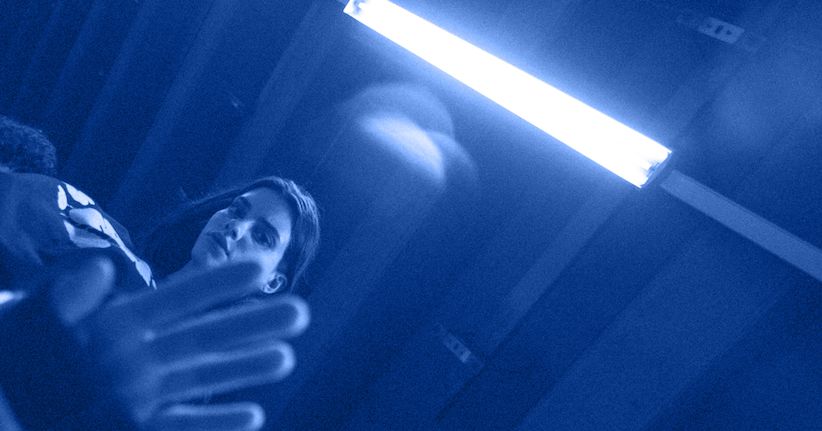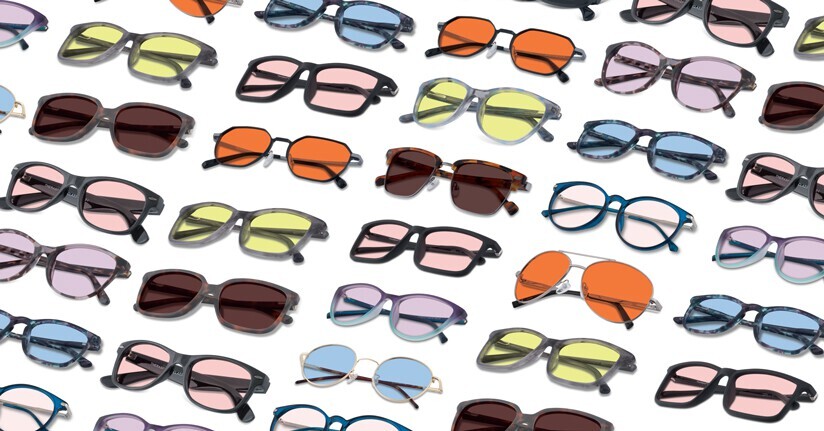Fluorescent Light Sensitivity: Causes, Symptoms & Solutions
There are probably those times where you have felt that you just cannot escape fluorescent lighting—from the office or the classroom to the neighborhood grocery store, its prevalence can be problematic, especially for somebody who is already sensitive. For decades, researchers have explored the effects of fluorescent light sensitivity on people, and we round up some of their key findings in hopes you are able to better understand your own experiences.
Symptoms of Fluorescent Light Sensitivity
Do you ever just feel gross after sitting under bright fluorescents for even a relatively short period of time? Chances are you have had this experience along with millions of others, and there are a litany of physical and emotional symptoms that develop as a result of your sensitivity to fluorescent lights. Like other symptoms of light sensitivity, fluorescent may lead to the following issues:
- Intolerance of fluorescents
- Eye strain
- Eye pain or inflammation
- Blurred or impaired vision
- Difficulty reading or focusing
- Headache or migraine attacks
- Vertigo or dizziness
- Lightheadedness
- Shortness of breath
- Nausea
- Lethargy
- Anxiety
- Feelings of depression
- Disrupted sleep
Some of these may manifest immediately or within a few minutes of exposure; however, there may be a delay in the onset of these symptoms as well—particularly in the case of some of the emotional side effects. There is also evidence that conventional fluorescent lighting can reduce productivity, negatively impact mood, increase mental and physical fatigue and even reduce alertness.1 And of course, these are even more likely to develop for a person who is already sensitive to light.

Fluorescent Light Headaches and Migraine Attacks
This is probably the million dollar question: Can fluorescent lights cause or trigger individual headaches or migraine attacks? The answer is certainly yes, and it is even more likely to act as a trigger if you already have a headache disorder—such as migraine with or without aura, vestibular migraine, or cluster headache, for example. In fact, more than half of women with any type of migraine are likely to be triggered by fluorescents; furthermore, the TheraSpecs team found that nearly 85% of chronic headache patients with accompanying photophobia reported that it was a significant catalyst for their attacks.2
However, the general population is not immune to the possibility of fluorescent-induced headaches. For example, researchers discovered that office workers exposed to conventional fluorescent lighting had twice as many instances of headaches when compared with more natural lighting environments.3 Moreover, workers are simply more likely to dislike fluorescent lighting due to the discomfort, high glare and headaches it can cause.6 In addition, eye strain is also a marker of fluorescent light sensitivity, and headache and migraine episodes are frequent complications of it.
Eye Problems from Fluorescent Light
There can be other eye-related issues associated with fluorescent light exposure. In addition to the immediate eye symptoms that patients often experience—such as ocular strain, inflammation, and excessive squinting—there is mounting evidence that fluorescents can be bad for your eyes in the long term as well. Australian researchers have suggested that the ultraviolet radiation of this type of lighting has led to an increase in eye diseases, most notably cataracts. Some medical professionals also have theorized that retinal damage, myopia or astigmatism could also be side effects of fluorescent light sensitivity, particularly due to blue light and overall brightness; however, more evidence is needed to determine if there is indeed a connection.4-5
Furthermore, we also know that those with inherent eye conditions like benign essential blepharospasm, dry eye or uveitis, are frequently more sensitive to fluorescent lights. Even a few minutes of exposure can increase photophobia and many of the other symptoms described above. Even if you have not been diagnosed with an eye disorder, fluorescent lighting has been shown to arouse the central nervous system, which can lead to eye discomfort, visual stress and diminished reading proficiency.7
What Causes Sensitivity to Fluorescent Lighting?
One of the biggest reasons why fluorescent light sensitivity is so prevalent has to do with the sheer amount of offices, schools and public places that utilize it as their primary light source. For decades, it was deemed the most efficient way to light a building, which unfortunately exposed workers and patrons to all of their negative side effects. A recent study from the American Society of Interior Designers showed that more than two-thirds of employees are unhappy with the lighting in their workspace. Just see how some American workers have described their issues related to fluorescent lights:

Source: medhelp.org
Thankfully, there is growing movement toward fluorescent alternatives, but it remains slow progress.
As we noted previously, another significant cause for fluorescent light sensitivity has to do with the underlying conditions of individuals. There are more than 35 million people with migraine alone, and the majority of them are likely to endure generalized sensitivity to light as well. Nine out every ten autistic individuals have environmental sensitivities, and fluorescents are often reported to worsen their sensory stress. TBI and concussion patients similarly have hypersensitive and/or diminished brain function from their injuries, which can make them susceptible to fluorescent lights. Artificial lighting has even been shown to trigger seizures in certain types of epilepsy.
Lastly, there are certain properties associated with fluorescent lighting that affect an individual’s tolerance levels. They include:
- High amount of blue light which is known to increase eye strain, general light sensitivity, headaches and migraines.
- Low-frequency flicker which is absorbed by the brain even though it is often imperceptible to the naked eye.
- Overall brightness can trigger light-sensitive conditions and also bring about other symptoms of fluorescent light sensitivity.
Solutions for Fluorescent Light Sensitivity

It is hard to imagine a society without fluorescent lights, so what can you do to relieve your sensitivity while we all wait for this magical, fluorescent-less utopia? Well, it typically will require a trial period with different products and environmental adjustments that can offer tangible relief against the harshness of this kind of artificial light. Below, we outline some options and strategies that you may want to try.
Treat the pre-existing condition
This should be a top priority if you are currently dealing with a chronic condition that makes you more likely to be sensitive to any light, much less fluorescents. Many experts agree that if you can treat the disorder, then you can improve the associative symptoms.
Fluorescent lighting alternatives at work
Talk with your employer about how the lighting affects your health and your ability to be productive, if appropriate. Suggest alternate workspace locations or request an increase in natural lighting and/or fluorescent diffusers. And if you need help, here are some more tips for convincing your boss to deal with light sensitivity in the workplace.
Tinted glasses for fluorescent lights
Have you considered using glasses that are designed specifically for fluorescent light sensitivity? They do exist, and may noticeably improve symptoms associated with fluorescent intolerance for 85-90% of those who try them AND they can help minimize the effects of digital screens and other light triggers. Hint: TheraSpecs fluorescent light glasses are one of your best options out there.
Increase natural light as much as possible
Although sunlight can lead to headaches and light sensitivity, it is still a much preferred alternative to artificial fluorescent lighting inside. Otherwise you may want to at least utilize warm-colored interior lighting through desk or floor lamps and/or swapping out the bright white light bulbs.
Related Reading:
How Light Can Trigger or Worsen Migraine Attacks
Light Sensitivity after a Concussion
Light Sensitivity and Autism Spectrum Disorder
Photosensitive Epilepsy: How Light Can Trigger Seizures
References:
1Hawes B, Brunyé T, Mahoney C, Sullivan J, Aall C. Effects of four workplace lighting technologies on perception, cognition and affective state. International Journal of Industrial Ergonomics. 2012; 42: 122-128.
2Hay KM, Mortimer MJ, Barker DC, Debney LM, Good PA. 1044 women with migraine: the effect of environmental stimuli. Headache. 1994 Mar; 34(3):166-8.
3Wilkins AJ, Nimmo-Smith I, Slater, AI, Bedocs L. Fluorescent lighting, headaches and eyestrain. Lighting Research & Technology. 1989 Feb; 21(1):11-18.
4Ham WT Jr. Ocular hazards of light sources: review of current knowledge.J Occup Med. 1983 Feb;25(2):101-3.
5Czepita D, Gosławski W, Mojsa A, Muszyńska-Lachota I. Role of light emitted by incandescent or fluorescent lamps in the development of myopia and astigmatism. Med Sci Monit. 2004 Apr;10(4):CR168-71.
6Robertson AS, McInnes M, Glass D, Dalton G, Burge PS. Building sickness, are symptoms related to the office lighting? Ann Occup Hyg. 1989;33(1):47-59.
7Loew SJ, Rodríguez C, Marsh NV, Jones GL, Núñez JC, Watson K. Levels of Visual Stress in Proficient Readers: Effects of Spectral Filtering of Fluorescent Lighting on Reading Discomfort. Span J Psychol. 2015 Aug 10;18:E58. doi: 10.1017/sjp.2015.59.

TheraSpecs® Glasses for Light Sensitivity
Find the glasses that fit your needs and lifestyle, and stay protected from screens, fluorescents, unwanted blue light, sunlight, flashing lights, and more.
Shop Now



